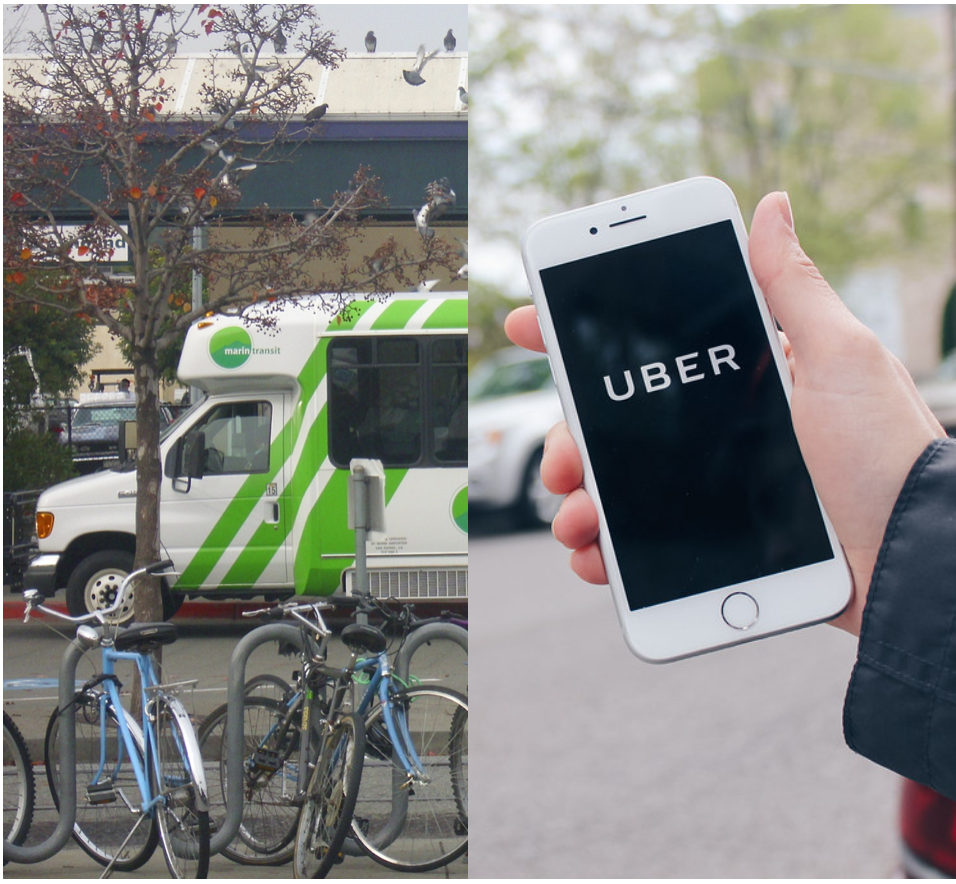A California transportation agency announced this week that it will pay Uber up to $80,000 to use the rideshare giant's app for fare collection, among other services. It sounds like another win for cars — but the program could be good news for transit if it's adopted in more cities, some argue.
San Francisco Bay Area agency Marin Transit signed a deal that will allow its riders to buy their bus tickets directly from the Uber app — agreeing to pay the company a subscription fee as much as $80,000 over two years for the use of its software. The move raised hackles among some transit advocates, who are skeptical of the e-taxi industry's corrosive impact on public transportation ridership.
But Marin Transit defends the move as a boon for disadvantaged riders. The program, Marin Connect, will allow users to request wheelchair-accessible paratransit vans, view transit schedules, and receive discounts on Uber rides to transit stops without downloading yet another mobility app to their phones. (The Bay Area has a staggering 27 transit operators, many of which have apps.) Uber will transfer all the fares it collects to the agency, and users can still pay cash on board if they choose.
"Let's face it: A lot of people already have the Uber app on their phones," said Cody Lowe, planning analyst for Marin Transit. "Being able to find transit within the Uber app environment is a good thing. Being able to compare prices with transit, and seeing a three dollar paratransit option right there alongside a more expensive rideshare option — that's a good thing. Especially if you’re an older adult, or a person with a disability, or an underbanked person who's struggled to access transit in the past."
Experts say the Marin program may be the first of its kind. (The Regional Transit District in Denver, Colo. has had a similar in-app fare collection partnership with Uber since May of 2019, but it's not clear whether its a subscription service. Uber did not respond to a request for clarification.) And if the model proliferates, it could have huge implications for our national transportation future.
The difference between Marin Connect and "Mobility as a Service"
Lowe's description of the Marin Connect partnership might sound like the much-buzzed-about "Mobility-as-a-Service" model of transportation — but it differs in important ways.
A Finnish idea, the MaaS model imagines a world where people wouldn't need cars because they'd have affordable access to rideshare, bikeshare, transit, short-term car rental, and more, all in a single app. Helsinki, which has embraced the concept, credits its publicly-subsidized MaaS app, Whim, with helping to reduce car ownership, grow bikeshare usage, and even eliminate traffic deaths in 2019.
But Marin Connect is a Software-as-a-Service program — and experts say the distinction is important. Most MaaS advocates think that, ideally, Uber would pay Marin Transit (or another government body) a subscription fee for hosting its service on a publicly funded mobility app — and so would every other private mobility provider. Such an arrangement would bolster public-transportation funding and give operators access to Uber's ridership data — enabling the public agency to address gaps in service without boosting taxi use.
In Marin's arrangement, that relationship is reversed. Uber will be able to see where transit riders are going in Marin — and could use the information to undercut public transit's prices and services.
America isn't Finland, either. The United States systematically underfunds transit agencies — and transit agency budgets have been badly battered by COVID-19. So developing, marketing, and implementing a publicly-subsidized MaaS app is a tall order.
"Creating your own white label app and having to develop and market that app at the same time — that'd be a big ask," said Derek McGill, planning manager for the Transportation Authority of Marin. "And realistically, these big companies already have that in place. Working with Uber's existing app gives us the ability, right now, to work with our local business community’s [post-quarantine] recovery efforts by helping their employees and customers reach their businesses affordably."
Is Uber becoming a friend to transit?
Yet for some transit advocates, the Uber-Marin program isn't just a necessary evil at a time of historic transit losses; it's a sign that Uber might actually serve as transit's ally. The e-taxi company itself is certainly selling that narrative.
“This is not a one-off. This is a new product and a new business,” said David Reich, head of Uber Transit, in a recent interview at Bloomberg about the program. “Together we want to make car ownership a thing of the past.”
Transit advocates might be wise to be skeptical of solidarity statements like these, especially coming from a company that once referred in an SEC filing to the existence of transit agencies as a "risk factor" to the company's success. The company later backtracked, but rideshare has been slow to shake the image of a would-be transportation monopoly intent on cannibalizing all public options. Data on rideshare doesn't support the idea that Uber helps transit, either: one study showed that Uber and Lyft reduced bus ridership in San Francisco a shocking 12.7 percent from 2010 to 2019.
Still, some transit professionals are optimistic that Uber's partnership in Marin could help reduce private car ownership — at least for now.
"It’s trying something new — and that’s the kind of time and place we’re in, especially since March [when the COVID-19 outbreak began in most states]," said Art Guzzetti, vice president of mobility at the American Public Transportation Association. "Our feeling at APTA has been that from now on, we'll figure things out one pilot at a time, one approach at a time, one service delivery model at a time. There is a strong inclination to move towards the spirit of mobility as a service — to see transit as the trunkline of a broader mobility system — and we hope projects like this can play a role in that. I guess we'll see."






